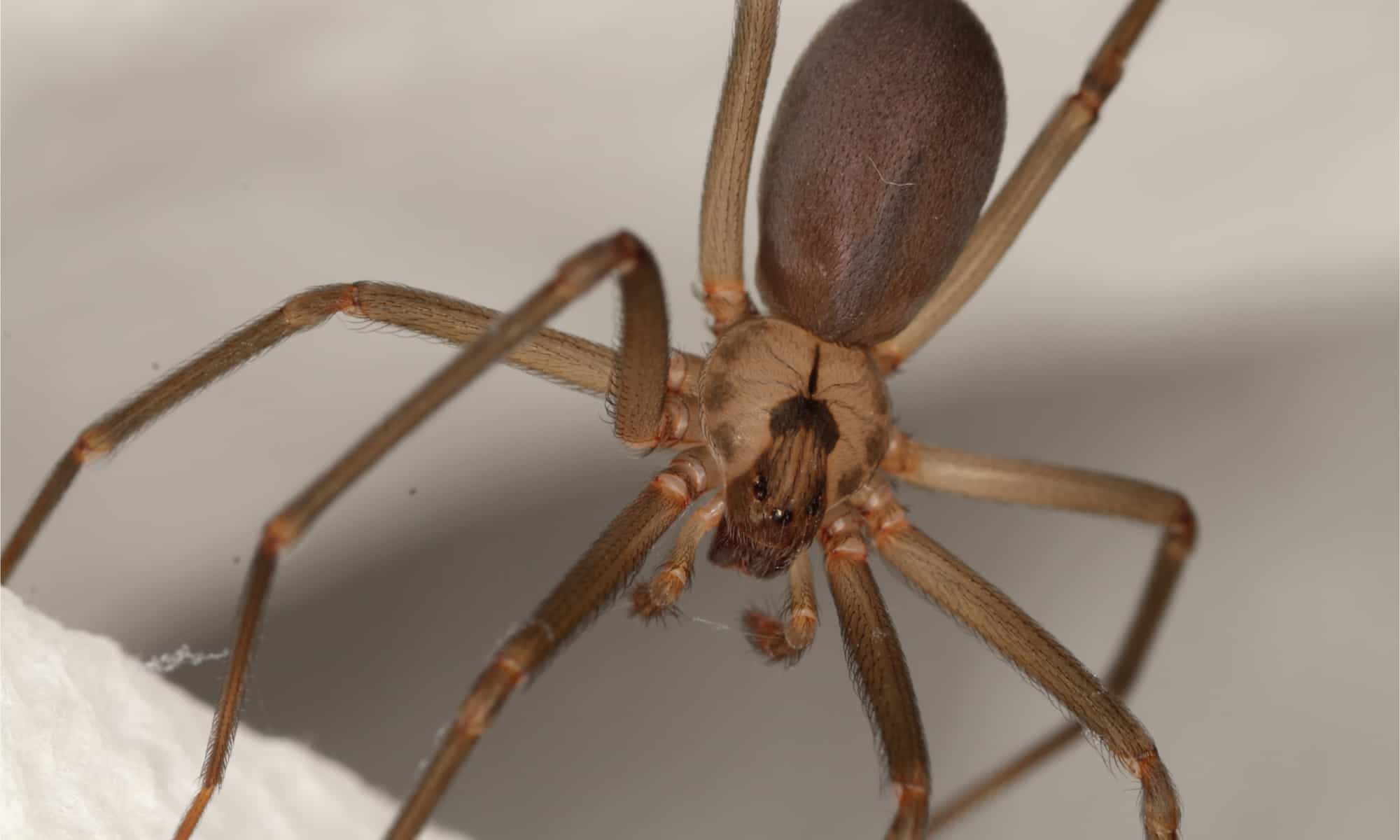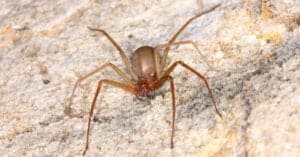The brown recluse spider, scientifically known as Loxosceles reclusa, is a creature that has captured the curiosity and concern of many due to its mysterious nature and potentially harmful bite. These spiders are known for their reclusive nature, hence their name. However, they also have a particularly venomous bite that can be troublesome.
While brown recluses are often associated with warmer, southern states, they can be found in Ohio, too. This may come as a surprise to many who thought Ohio was outside of the spider’s range.
This article will provide Ohio residents and other interested readers with everything you need to know about the brown recluse spider. We’ll look at how these spiders look, where they’re at in the state, and practical tips for managing them in your home.
What is a Brown Recluse Spider?
The brown recluse spider belongs to the family Sicariidae. These spiders are part of the order Araneae, which includes all true spiders. Loxosceles comprises approximately 100 species, but the brown recluse is one of the most notorious.
Physical Characteristics
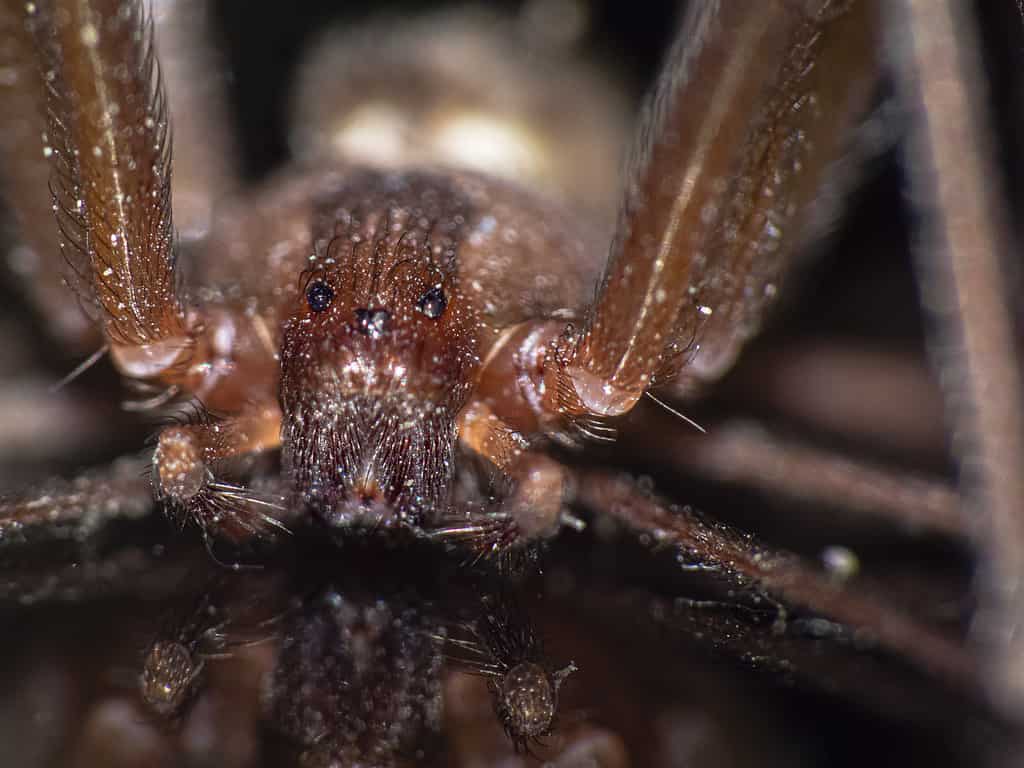
Notice the
sixeyes arranged in three apparent pairs.
©iStock.com/Wirestock
These spiders are relatively small compared to other arachnids. They typically measure about 1/4 to 1/2 inch in body length, with legs that span around 1 to 1.5 inches. They’re brown, as you may expect from their name. However, they can range from light to medium brown.
These spiders have a few distinctive properties that make them easy to identify. The biggest one is the violin-shaped marking on the top of their back (aka, their cephalothorax). This marking isn’t a foolproof way to identify them, as not all brown recluse spiders have it. However, when you see it, you likely have a brown recluse on your hands.
Their legs are also completely uniform in color. They lack any conspicuous bands or stripes.
Behavior and Habits
Brown recluse spiders are predominantly nocturnal creatures, which means they are active at night. For this reason, they’re very elusive and less likely to be seen during the day.
Unlike most other spiders, brown recluses create irregular, messy webs. They are not the intricate, symmetrical webs you may expect a spider to make. Their webs are often built in hidden, sheltered places like cracks and crevices. They don’t rely solely on their web to find prey. Instead, they actively seek out insects and other small arthropods.
Distribution in Ohio
Brown recluse spiders are well-documented in Ohio despite being colder than their prime habitat. However, they are not distributed evenly across the whole state. Instead, they are concentrated mainly in the southern and southwestern regions. Counties like Adams, Scioto, Highland, and Ross in south Ohio have reported more instances of brown recluse sightings than other areas of the state.
Of course, it is probably because these areas are warmer.
Southern Ohio has a particularly high number of brown recluse spiders. They are mainly found along the borders of Kentucky and West Virginia. Simply put, the further south you are, the more likely you will find a brown recluse.
Southwestern Ohio is also known for having a decent number of spiders. Areas around Cincinnati have reported several brown recluse sightings, likely due to their proximity to the southern region.
Of course, there are other isolated reports around Ohio, too. Just because you don’t live in southern Ohio doesn’t mean you won’t see one of these spiders. However, living further north will lower your chances.
Factors Affecting Distribution
There are many factors affecting the distribution of brown recluse spiders around Ohio. Here are some things to consider:
- Climate: Brown recluse spiders prefer warmer, drier climates. Therefore, southern and southwestern Ohio tend to have the most favorable conditions, making them the best place to find these spiders.
- Habitat Preferences: Brown recluse spiders are known for being very adaptable. Therefore, they’re able to live in a wide variety of places. They can be found in both natural and artificial environments. However, they need dark, undisturbed spaces and ample prey. These conditions can often be found in sheds, garages, and basements.
- Human Activity: Humans can inadvertently transport these spiders from one region to another. They’re known to hitch a ride in boxes, furniture, or other items. Because they tend to stay out of sight, it’s easy to transport them without realizing it.
Habitats within Homes
One of the first steps to identifying and avoiding brown recluses is to know where they can be found. As we’ve stated, they can often live alongside people without a problem, so there is a chance you will find them in your home.
Common Hiding Spots
You’ll find brown recluses most commonly in dark areas of your home. These include:
- Closets: Dark corners of closets, especially those containing clothing or clutter, provide ideal hiding spots for these spiders.
- Basements and Cellars: The lower levels of homes are often cool, dark, and less frequently visited, making them attractive to brown recluse spiders.
- Garages and Sheds: These structures offer shelter and protection from the elements, creating suitable habitats for brown recluse spiders.
- Attics: Attics can also appeal to brown recluse spiders, especially if they are rarely accessed.
As stated, brown recluse spiders do not create large, visible webs. Therefore, being on the lookout for spiderwebs won’t help you. Instead, they spin irregular, tangled webs in hidden corners and crevices. Their webs are mostly used as a place for the spider to live rather than catching prey.
One telltale sign of brown recluse spider activity is the presence of shed exoskeletons. Spiders periodically molt, leaving behind their old exoskeletons. If you find these delicate, translucent shells in dark corners or crevices, it may indicate the presence of brown recluse spiders.
Signs of a Brown Recluse Spider Infestation
Identifying brown recluses can be challenging due to their secretive nature. However, there are a few things you can look out for.
Stay looking for irregular, messy webs in many dark locations, like behind furniture. These webs may or may not contain the spider itself or egg sacs.
You can also look for shed exoskeletons, though this is less foolproof than seeing the spider itself. Often, for enough exoskeletons to pile up, there would need to be an ongoing population.
Identifying a Brown Recluse Spider
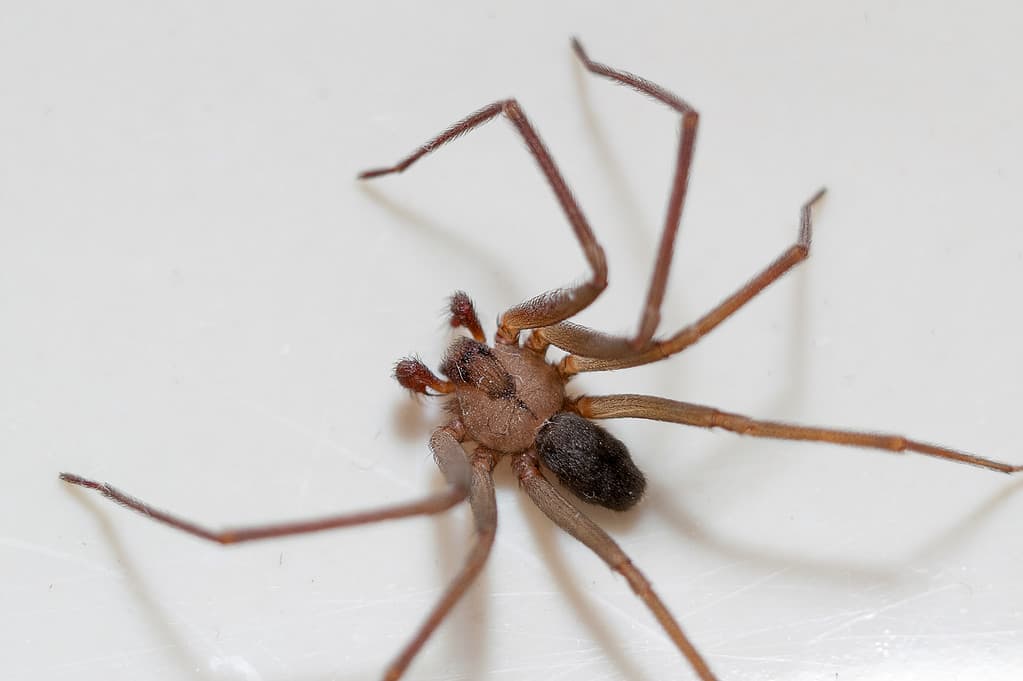
Brown Recluse Spiders typically have a violin-shaped marking on their back.
©benjaminjk/ via Getty Images
If you spot a spider, it’s important to identify them accurately. Many spiders look similar to the brown recluse but are completely harmless. Some harmless spiders may even prey on brown recluse spiders, so killing them is the opposite of what you want to do.
Here are some of the most obvious characteristics to look for:
Eye Arrangement
One of the most distinguishing features of the brown recluse is its eye arrangement. Unlike many spiders, brown recluse spiders have six eyes arranged in pairs in a distinctive pattern. This is completely different from most spiders, which tend to have eight eyes in two rows.
However, this eye configuration can be challenging to discern without magnification. When in doubt, though, it’s helpful to look for.
Fiddle-Shaped Marking
If you suspect a spider is a brown recluse, look for the fiddle-shaped marking on their back. Most brown recluse spiders have this marking, though not all do. It can be very faint in some individuals, so don’t let it be the sole factor you use for identification.
Leg Coloration
Most spiders out there have stripes on their legs. However, a brown recluse’s legs are completely solid and have the same hue as the rest of the body.
How to Differentiate from Similar Species
Several species look similar to the brown recluse. While looking for the characteristics we listed above can be helpful, it’s also important to differentiate similar-looking spiders that are harmless.
Here are two species that look similar:
Wolf Spiders
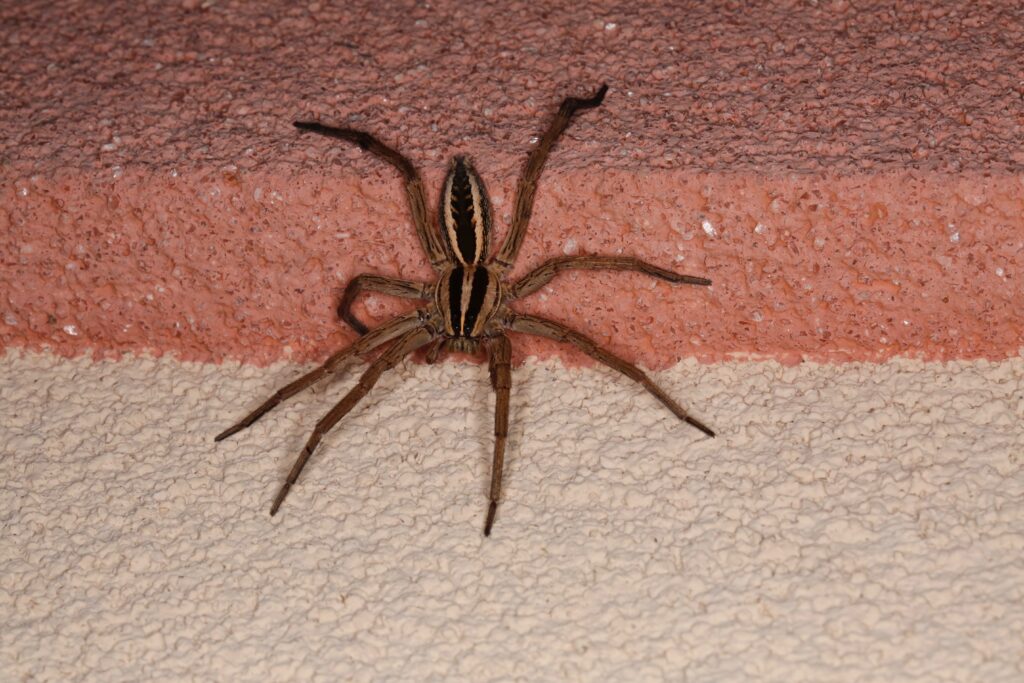
These spiders are brown, furry, and have different back patterns.
©Cathleen Wake Gorbatenko/Shutterstock.com
Wolf spiders are often mistaken for brown recluses due to their similar size and coloration. However, they have a different eye arrangement, with eight eyes in two rows, and lack the distinctive fiddle-shaped marking. Instead, they have one line that goes down their back.
They’re also less lanky than brown recluse spiders and more likely to be out and about. If you see a brown spider wandering around in the grass during the day, it will likely be a wolf spider – not a brown recluse.
Sac Spider

Notice the differences between a sac spider and a brown recluse.
©Judy Gallagher / CC BY 2.0 – License
Sac spiders are brown, but they have eight eyes in two rows. They also don’t have the fiddle marking on their back. However, they may be found in similar places to the brown recluse and make the same messy webs. Therefore, identification can be a bit confusing.
When in doubt about the identification of a spider, it’s advisable to exercise caution and avoid handling it. If you believe you have encountered a brown recluse spider or are uncertain about its identity, consider capturing it safely in a container and contacting a pest control professional.
Dealing with Brown Recluse Spiders in Your Home
If you find a brown recluse spider in your home, it can be unsettling. However, it’s important to remain calm and respond appropriately. Here are some steps we recommend taking:
Importance of Proper Identification
Firstly, you should ensure you’re looking at a brown recluse. These spiders are rare in Ohio and tend to keep to themselves. So, seeing one is very rare. Mistaking a harmless spider for a brown recluse can harm the beneficial species and lead to unnecessary stress.
Be sure you check and double-check the characteristics we listed above.
Avoidance and Prevention
You can prevent brown recluse spiders from entering your home in many ways. Often, prevention is better than treatment.
Brown recluse spiders like to be hidden so that they will seek out dark places. Regular cleaning and decluttering will eliminate places for this spider to hide, preventing them from setting up inside your home. Please pay close attention to basements, closets, and attics, where they are more likely to hide.
Be sure to seal cracks, gaps, and crevices in your home. Brown recluse spiders love these areas, so making them inaccessible is essential. We also recommend focusing on windows, doors, vents, and pipes, which tend to have crevices around them.
You can also place sticky traps or glue boards in potential hiding places, such as dark closets and corners. However, all species will be susceptible to these traps, so they are only recommended in homes with previous infestations.
When to Call a Professional Pest Control Service
Consider calling a professional pest control service if you see a brown recluse in your home. Where there is one, there is usually more. Therefore, it may be a sign that it’s time for you to seek professional help.
What to Do if Bitten
Brown recluse bites are exceptionally uncommon. However, they can be serious in some circumstances. Do the following steps if you are bitten:
- Wash the area gently with soap and water.
- Apply a clean, cold compress to reduce pain and swelling.
- Seek medical attention promptly, especially if you suspect a brown recluse bite. Medical professionals can provide appropriate treatment and monitor the wound.
Thank you for reading! Have some feedback for us? Contact the AZ Animals editorial team.

